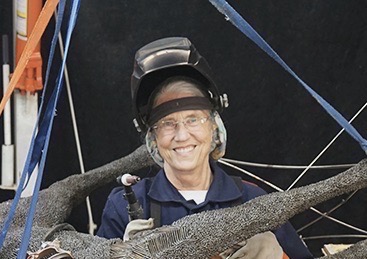
“My parents were avid ornithologists.
While growing up, at the drop of a hat, they would leave home for any corner of the globe to see a rare bird.
Through osmosis, I gleaned my love of birds and all creatures from this constant influence from my parents’ passion and involvement with nature.”
The Making of the Panther
Interview with WXXI: Snow Geese Sculpture
Click to listen to audio recording
Mary’s Bio
Sculptor Mary Taylor is inspired by animals, and she is able to observe them–their beauty, their habits, their cooperation with each other–every day at her Honeoye Falls, NY home. “I live in the country and my natural surroundings along with the wild animals that live near me continually fill me with excitement and inspiration,” she said. In order to stick to her daily working schedule, it is very important for Taylor to be in nature with very little of the material world for distraction. The studio on her property is her sanctuary where she sinks into a deep calm, takes the rod and torch in her gloved hands, and begins to bend lines. “I do have an objective when I begin to shape a creature, but to me, the miracle and the mystery speak through line,” she said. “The expressed energy in a curved line is the connection which communicates to the viewer.”
Growing up in a creative household, Taylor had an affinity for art early on. In the last 50 years, she has constructed interior and exterior sculptures of wildlife in both mild and stainless steel. Taylor’s creative style is unique, welding small steel rods to create animate forms with light shining through. “Within the structure of each sculpture, I space the welding rods slightly apart to allow light to penetrate through the completed work. When backlit, this technique animates the sculpture with twinkling light, which, in turn, creates excitement and fascination.” This technique, combined with the expression of life emanating through the sculpture, makes her works popular with viewers. Along with her smaller sculptures, Taylor has constructed large public works for both galleries and private collections, nationally and internationally. “I feel deeply moved and gratified when I complete a sculpture larger than myself.
Taylor’s sculptures have sold nationwide and internationally.
Steel, Spirit, and the Wild: The Art of Mary Taylor
Art Review by Circle Foundation for the Arts – April 2025
American artist Mary Taylor, born in 1947 in Rochester, New York, has cultivated a singular sculptural practice over the course of five decades. Educated at institutions such as the Rochester Institute of Technology, University of the Pacific, and American University, Taylor also trained in sculpture at the Woodstock School of Art and studied biological illustration, drawing, and encaustic painting to deepen her material and conceptual vocabulary. Her long-standing commitment to the arts has been matched by a deep reverence for nature, with a focus on preserving and celebrating wildlife through her sculptural forms.
Taylor’s body of work is rooted in a profound engagement with the natural world. Working primarily in mild and stainless steel, she welds intricate, lifelike sculptures of animals, from birds and wolves to domestic creatures, each animated with remarkable detail and vitality. Her commissions and public artworks can be found across the United States and internationally, from memorials and private collections to institutions like the San Bernardino County Museum and the Memorial Art Gallery in Rochester. Throughout her prolific career, she has consistently returned to themes of survival, extinction, and the interconnectedness of life. Her ongoing exploration of these ideas culminates in emotionally resonant works that act as sentinels of ecological consciousness.
The sculptures themselves are technically mesmerizing. Taylor uses steel rods to construct dense, directional forms that create a tactile surface suggestive of fur, feather, or flesh. In “She-Wolf,” a life-sized wolf prowls forward, every muscle tensed beneath the bristling steel filaments that make up its fur. This sense of latent energy, poised between motion and stillness, evokes the lineage of animal representation in art—from Paleolithic cave paintings to the dynamic bronze forms of Barye and Bugatti. By contrast, the portrait-style bust of a dog in “Companion” renders domestic intimacy with gentle fidelity. The detailed facial expression, achieved through precise variations in rod density and color, speaks to both the animal’s uniqueness and the emotional intelligence we project onto our companions. Taylor’s formal language—marked by rhythmic repetition, directional gesture, and anatomical precision—places her in dialogue with contemporary sculptors who bridge realism and conceptual intent, such as Deborah Butterfield and Beth Cavener.
What makes Mary Taylor’s practice particularly vital in the contemporary moment is her unwavering commitment to the natural world—not merely as subject matter, but as a deeper philosophical and spiritual concern. Her sculptures are not static representations; they are embodiments of life-force and vulnerability. They communicate across species lines, evoking empathy, awe, and reflection. In a time of ecological crisis and extinction, Taylor’s work functions as both elegy and call to awareness. Her mastery of steel—a material often associated with industry and permanence—transformed into delicate expressions of breath and movement, reinforces a message of resilience, interdependence, and reverence for life in all its forms.